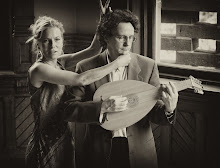On Monday we did a class at the lovely campus of Glendon College, York University. The course was called ‘Performing the Baroque’, a Drama course taught by Guillaume Bernardi.
First we demonstrated what Renaissance music sounded like, using as an example Donna s’el cor di ghiaccio by Ippolito Tromboncino. Tromboncino was a Venetian, famous as a singing teacher. He was friends with Pietro Aretino, a great satirist of the 16th century, who in a letter invites Tromboncino to dinner, saying that the courtesan, and Ippolito’s student, Francheschina will be there, as will the great painter Titian. A painting of Titian’s shows a disinterested Venus staring off into the distance as a lute player serenades her longingly. Could this be Ippolito and Franceschina?
In this music the written out lute parts imitates the different voices of an imaginary choir, something that Vincenzo Galilei, father of the famous astronomer, and co-inventor of Baroque music says is an import into vocal music from instrumental music, though he was probably wrong about that. ‘Thus the cithara players, wishing to make up for this defect (that is being unable to deliver poetry) introduced on their instruments a way of playing several airs together in consonance.’ Like a good late Renaissance man, Vincenzo thinks that musicians should imitate the Ancients, who would declaim ‘lyric’ poetry to the lyre (now replaced by some kind of lute). Further, and still in the spirit of the Renaissance, he wrote, ‘the most important and principal part of music is the imitation of the concepts of the words’ and that the best musicians would observe ‘the man infuriated or excited, the married woman, the clever harlot, the lover speaking to his mistress as he seeks to persuade her to grant his wishes, the man who laments…’ As an example of this prescription we performed Amarilli mia bella, the greatest hit of the early Baroque, from Vincenzo’s colleague Giulio Caccini from his Le Nuove Musiche. The part for the lutenist or chitarrone player (an instrument also called ‘theorbo’ and recommended by Caccini as the best accompanying instrument) is now only a slow bass line, over which chords are improvised. The accompaniment gets out of the way so the poetry can be uttered in the rhythm of speech.
Caccini was involved in what is usually credited with being the first opera. So we moved on to perform one of the most influential pieces from an early opera, performed at a court wedding to a small audience of cognoscenti, the Lamento d’Arianna, by Claudio Monteverdi with words by Rinuccini. Arianna has been dumped on a beach by her husband, and is almost schizophrenic with grief, anger and every other emotion in between. Of course this is a treat for a composer to show off how a princess speaks, shrieks and rants as she goes through the catalogue of emotions, and the performer gets to show off what we’ll call her ‘musico-rhetorical’ skills too. Hallie talked about how the formalized gestures used by actors, singers and in fact, anyone who gave a speech in the Baroque moved from one pose, held it, then to another. The music of Montevedi reflects this as she runs the gamut of affections.
But of course, writing for a bunch of courtly eggheads in a salon is quite different from tickling a ticket buying public’s ear. As opera moved to opera houses from court chambers there were increasingly tuneful sections built on repeating chord structures and bass lines. We demonstrated this with some chunks of Barbara Strozzi’s Lament, which imitates Monteverdi’s in some parts, but integrates some of those more tuneful parts over a bass that is easier for the ear to hang on to. (The Strozzi is not from an opera, but uses some of the same stylistic characteristics.)
Barbara Strozzi was possibly a courtesan as well.
Building decorations on top of a solid superstructure is, of course, a crucial part of Baroque architecture, so adorning a repeating ‘ground bass’, as such basses were called in English, with a highly decorative vocal line is a sort of musical counterpart to that. We performed Caccini’s Torna, deh torna which is built on the Romanesca chord changes, changes better known in English as ‘Greensleeves’.
After all these hardcore intellectual compositions, we finished off with an ear tickler to demonstrate that everyone still liked a light canzonetta. We sang Caccini’s Dalla porta d’oriente, to a text probably by Maria Menadori.
Much of this music will be heard on our upcoming concert at St. Mike’s College on Nov. 13th.






No comments:
Post a Comment